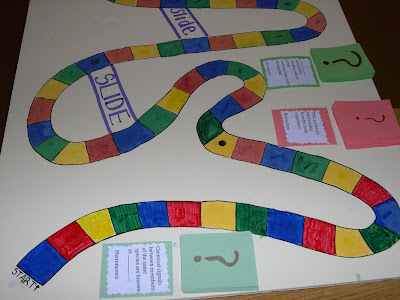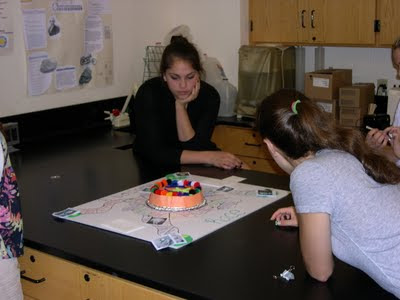Upon completion of the AP examination, the seniors in the course had a number of options for a project to be completed before "senior week" festivities. The seniors could choose to "shadow" a professional to learn what it is like to become a member of the "work force". They could volunteer their time working with the elementary school science specialist. This year helped the second graders with their Space Science Unit. The last option was to produce a board game that would teach/explain, through its play, a topic covered in the course this year.
Fourth Quarter First Project Newsletter 2011
The AP students, who chose to work with Mrs. Monaco's class, describe their experiences.
AP Biology Elementary School Helpers 2011
Brad and Sarah created the game "Biopoly" with a board based on the Parker Brothers game, Monopoly.
Instructions
- Every player starts with 120 cells.
- One only stays in the hospital for three turns.
- You do not have to pay cells if you land on an organ owned by someone else.
- If you lose all your cells, you LOSE!!
- Only one roll of dice per turn.
- Only four players can play at any one time.
- If you roll an even number and land on a vacant space, then you must answer a question correctly to buy the spot, If you roll and odd number it doesn't matter
- If you want to sell your organ but no one wants to buy it, the mortgage will be 10 cells less than you bought it for. If the organ is worth 10 cells, then you will get nothing for it.
- If everyone wishes to end play, then the player with the most cells after mortgages are taken into account will be the winner.
Ally and Lizzi designed the original game "Digestive Diversion"
The purpose of their game focused testing the game player's knowledge of the systems of the human body. Their question cards quizzed players on important factoids about the immune, excretory, digestive, and reproductive systems. As few as two players to as many as 6 players may play.
The game starts in the oral cavity and players proceed through the system by correctly answering random questions on the systems.
Instructions
- Shuffle the question cards and the exclamation cards separately and place them on the designated spaces on the game board.
- Each player picks a playing piece.
- The youngest player goes first.
- The person to the left of the player picks the top question card and reads it to the player.
- The player answers the question. If answered correctly, the player moves the number of spaces indicated on the question card.
- If answered incorrectly the player does not move.
- If the player answers correctly, moves, and lands on a "!", they pick an exclamation mark card and follow the instructions on that card.
- The next youngest player goes and follows the same steps.
- The first player to make it through the digestive system wins.
Renato created the "Ecoventure: Deluxe Edition" game to reinforce/review learning related to Ecology.
Instructions
- Each player gets a game piece with a number, they then roll the dice in number order.
- The object of the game is to be the first player to reach the end of the board.
- Before each turn the player draws a question card and attempts to answer the question; a correct answer gives the player the right to roll the dice for movement.
- Incorrect answers results in a movement of only one (1) space. Other players may answer a missed question for a gain of one (1) space.
- If a player lands on a "Challenge Space", they have the option to draw another question; if answered correctly the player may move the same number of spaces as the dice role which resulted on landing on the "Challenge Space".
- Answering a "Challenge Space" question incorrectly results in losing double (2x) the spaces gained by their original dice roll.
- Challenge questions cannot be answered by other players in the game.




Jane created the game "Bio-Dome", which refers to the movie of the same name starring Billy Baldwin and Paulie Shore.
Object of Bio-Dome
The object of Bio-Dome is to travel through the Bio-Dome along the colored squares. The Moves are made according to the numbered cards that the players draw. The player who has accumulated the highest number of points after they cross the "FINISH" line is the winner.
Instructions
- Shuffle the numbered cards well and place them on the square marked "#". The youngest play should go first.
- Each player chooses a playing piece. All players begin the game on the square marked "START" and travel along the path of squares. The player moves foward on the path by the number of squares that is printed on the "#" card drawn.
- When a player lands on a square, they must pick up a card from the top of the pile marked "QUESTIONS" and proceeds to answer the question. Correct answers earn a point.
- If and when the "Chaos Theory" card is drawn, the player who has drawn the card waits until the reach the "Chaos Bridge". Once there they are to pick up the deck of cards marked "CHAOS THEORY (Ct)" and scatter them onto the table. All the players are now eligible to attempt to pick up as manner cards as possible, Each card picked has a point value and these points are added to the players score.
- If all the cards are used and the game has not finished, the cards are reshuffled and put back into their proper piles.

Winning the Game
When all players cross the "FINISH" line, the game is over. The player with the most points accumulated is the winner!.
Tony and Ryan created the game "Cell Life", which is based on "cellular" forms of life. The rules of their game are as follows:
John created the game "Waterfall" to reinforce the chemical properties of water and their importance to life.




































































